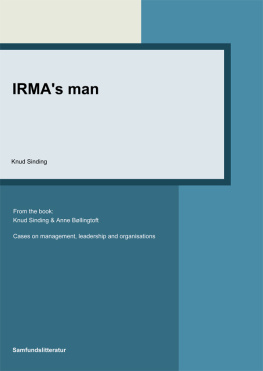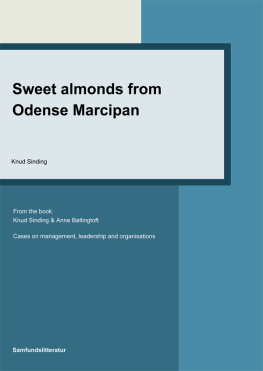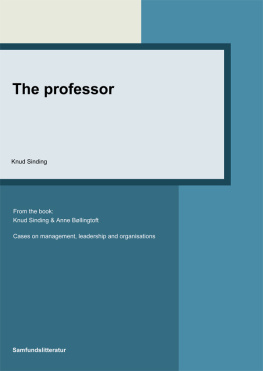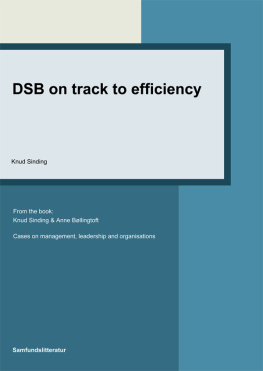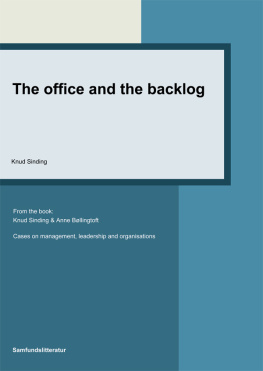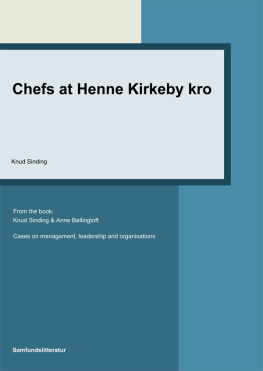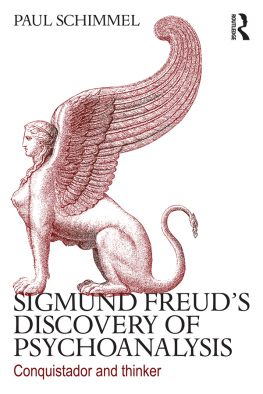Sinding - Irmas man
Here you can read online Sinding - Irmas man full text of the book (entire story) in english for free. Download pdf and epub, get meaning, cover and reviews about this ebook. City: Samfundslitteratur, year: 2013, publisher: Samfundlitteratur;[Sælges på internettet], Samfundslitteratur, genre: Home and family. Description of the work, (preface) as well as reviews are available. Best literature library LitArk.com created for fans of good reading and offers a wide selection of genres:
Romance novel
Science fiction
Adventure
Detective
Science
History
Home and family
Prose
Art
Politics
Computer
Non-fiction
Religion
Business
Children
Humor
Choose a favorite category and find really read worthwhile books. Enjoy immersion in the world of imagination, feel the emotions of the characters or learn something new for yourself, make an fascinating discovery.
- Book:Irmas man
- Author:
- Publisher:Samfundlitteratur;[Sælges på internettet], Samfundslitteratur
- Genre:
- Year:2013
- City:Samfundslitteratur
- Rating:3 / 5
- Favourites:Add to favourites
- Your mark:
- 60
- 1
- 2
- 3
- 4
- 5
Irmas man: summary, description and annotation
We offer to read an annotation, description, summary or preface (depends on what the author of the book "Irmas man" wrote himself). If you haven't found the necessary information about the book — write in the comments, we will try to find it.
Irmas man — read online for free the complete book (whole text) full work
Below is the text of the book, divided by pages. System saving the place of the last page read, allows you to conveniently read the book "Irmas man" online for free, without having to search again every time where you left off. Put a bookmark, and you can go to the page where you finished reading at any time.
Font size:
Interval:
Bookmark:
Knud Sinding
IRMAs man

Knud Sinding
IRMAs man
From the book:
Knud Sinding and Anne Bllingtoft
Cases on Management, Leadership and Organisations, 1st edition 2012, chapter 17
1st e-book chapter 2013
Samfundslitteratur 2012
Cover design: Klahr|Graphic Design
Typeset: SL grafik, Frederiksberg
E-book production: Rosendahls BookPartnerMedia
ISBN: 978-87-593-9526-4
Samfundslitteratur
Rosenoerns All 9
DK-1970 Frederiksberg C
Denmark
Tlf: + 45 38 15 38 80
Fax: + 45 35 35 78 22
www.samfundslitteratur.dk
All rights reserved.
No part of this publication may be reproduced or used in any form or by any means graphic, electronic or mechanical including photocopying, recording, taping or information storage or retrieval system without permission in writing from the publisher.
CHAPTER 17
IRMAS MAN
The good boss is an elusive figure. Personality, history, intelligence, the specific situations, the subordinates, superiors and location all play their role in shaping what defines a good boss. These numerous variables also make it difficult to generalise, but some understanding of what characterises a good boss may still be gained.
Managing is difficult. Managers who have had enormous success in one place fail when they move to another place. Other managers perhaps deliver solid but not very exciting results no matter where they manage. Some hold on to the job, which made them successful, others bask in their success and perhaps use it as leverage for even greater results and more glory.
Good managers are likely to have played some role in making the largest companies what they are. Casual observers often equate company growth (in size, profitability, innovation etc.) with great management and leadership skills. Journalists happily ask managers of big companies about the recipe for their success. The replies are rarely illuminating, but on occasion a top executive can have something interesting to say.
In recent years, one of the exceptions has been the CEO of IRMA (a Danish supermarket chain), Alfred Josefsen. As an author of two books about his personal view of management, he makes many more appearances in the media than do managers of much bigger Danish companies. However, the story, which has brought Josefsen to his current iconic position, began in a dairy outlet in Copenhagen. It was the forerunner to the medium sized chain of supermarkets under the well-known (in the greater Copenhagen area) IRMA brand.
The IRMA chain started out with one shop in Nrrebro, Copenhagen, in 1886. Here, Carl Schepler opened his first dairy outlet. A dairy used ice for cooling raw milk to separate the cream fraction from the milk, but, at this time, centrifuges were on their way to taking over the work.
A dairy outlet instead became a fresh-food shop, which not only delivered milk and cream but, over time, also other dairy products. A portion of the supplies were also directly delivered to individual households. The dairy outlet was a product of the rapid urbanisation, which followed the industrialisation at the end of the 19th century and beginning of the 20th. Until the death of Carl Schepler in 1942, the chain grew to include 80 outlets. The first IRMA store with modern self-service (supermarket style) opened in 1950, and this type of store grew to dominate. From 1951, the chain, which was then owned by a number of egg wholesalers, was managed by Brge Olsen who, with great ingenuity, developed new types of products (for example bottled Norwegian spring water) and innovative and aggressive marketing (Olsen started a public brawl against the municipality of Copenhagen with provocative advertisements stating that drinking tap water wasnt healthy). Under Olsens management, the chain grew to include 120 supermarkets by the time he retired in 1979. The chain chose a strategy with considerable vertical integration, drawing on its own factories for tinned goods, coffee, milk, meat, soft drinks, etc. and with its own product brands/trademarks.
Disaster struck IRMA-land in 1982. The previous owners of IRMA decided to sell the chain to FDB (Danish Coop). Staunch IRMA customers were in an uproar: The new owners would ruin IRMA. It happened pretty much as expected. The chain experienced long downswing, which caused it to lose many stores (54 were converted to other chain names under FDB) and many CEOs. In the 1990s it was particularly difficult to be a CEO in the IRMA chain, which was managed by five different CEOs in the seven years leading up to 1999. Often, as in 1993, 1994, 1998 and 1999, a new strategy was launched with each new CEO.
The latest strategy change was made with Alfred Josefsens appointment in 1999. At this time, Josefsen stated, a little sourly, that it was difficult when competitors had copied all of IRMAs good ideas; fresh produce, new types of goods, organic food and inspiration. If IRMA was to survive, it would be necessary to take stock of customers preference for discount stores the prices at IRMA had to be reduced.
Chocolate man
After the rapid CEO turnover and a long period (1982-99) with disappointing or bad financial results, the appointment of Alfred Josefsen was likely to be IRMAs last chance before the parent company decided to sell or close the IRMA brand. He had been working as an independent consultant, after having chosen to leave his position as sales and marketing director at Toms (a large chocolate and candy company), due to frustrations with a stiff and very bureaucratic organisation. IRMAs parent company (Danish Coop) was at this time run by Steen Gede, who had worked with Josefsen in connection with a major cleanup of the grocery wholesaler Dagrofa.
A couple of years later, in 2003, Josefsen said the following about the interaction between employees during his first time at IRMA:
Its about encapsulating and eliminating the negative atmosphere and then its full speed ahead. We had to look forward instead of backwards. I made it clear to them that it was up to them to win this battle. It was their initiative and salesmanship that would create profits. The only thing that could save us was ourselves.
The essence of the changes Josefsen carried out was delegating responsibility to the individual stores, formulating clear objectives (big and small) and focusing on profitability in everything IRMA dealt with. The results came immediately. The operating deficit was gone at the beginning of 2000.
We had an extremely high rate of change. We had a solid management team, we had a solid plan, and we calmed our owners over the course of a few months [] The turnover rate of management staff is almost zero today.
At the same time, Alfred Josefsen described his approach to management:
The consequence of wanting to regulate and control a company is that it will be less productive than it otherwise could have been. A controlling or regulating management style should only be chosen after the lower production has been taken into consideration. If you want to regulate everything, you just have to accept that you wont get much out of it. If you trust that there are some people who want to create results, even though youre not in control of everything, you can get a better outcome. IRMA couldnt fail by experimenting because each individual experiment was a small one. [] [Everyone] has a duty to try to improve themselves by trying to work differently, by organising themselves differently. At the same time, you have to provide security by saying that even if it doesnt work out, nobody is going to be fired, shouted at or reprimanded.
The distinctive Josefsen style has connections to an earlier Scandinavian management icon, Jan Carlzon who led Scandinavian Airlines (SAS) from 1981 to 1993, and whom Josefsen had come to know in connection with his first job after graduating from the consulting firm IKO. Carlzon also wrote books about his work and his thoughts on management.
Next pageFont size:
Interval:
Bookmark:
Similar books «Irmas man»
Look at similar books to Irmas man. We have selected literature similar in name and meaning in the hope of providing readers with more options to find new, interesting, not yet read works.
Discussion, reviews of the book Irmas man and just readers' own opinions. Leave your comments, write what you think about the work, its meaning or the main characters. Specify what exactly you liked and what you didn't like, and why you think so.

